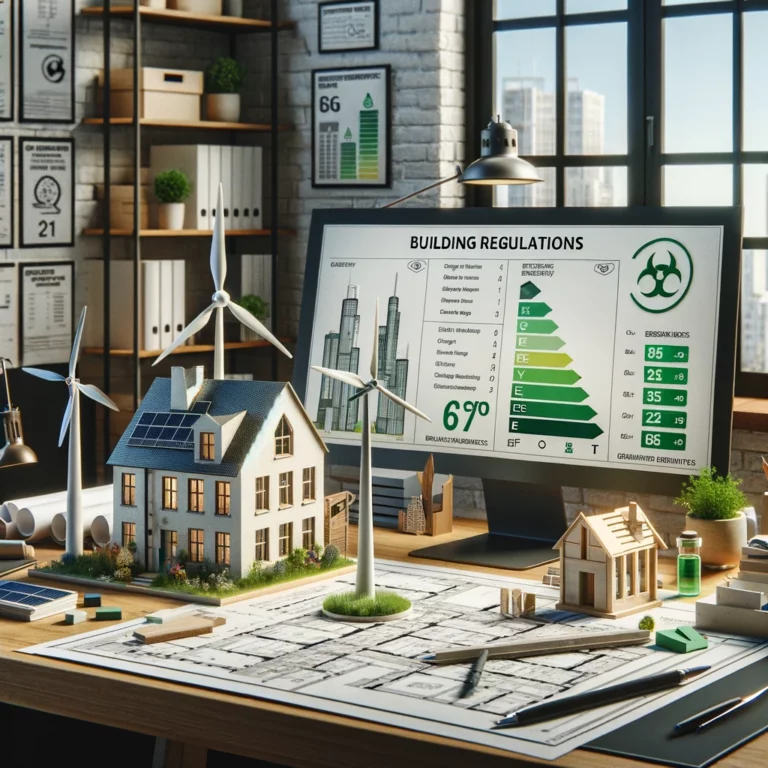Sustainable Energy and Building Regulations

Introduction
In Ireland, the integration of sustainable energy solutions into both new builds and existing structures is increasingly guided by stringent building regulations. These regulations are designed to improve energy efficiency, reduce greenhouse gas emissions, and encourage the use of renewable energy sources. Understanding how sustainable energy projects intersect with building regulations is crucial for developers, architects, and homeowners alike. This guide provides an in-depth look at energy efficiency standards, renewable energy integration, and the pivotal role of building regulations in promoting sustainability within the Irish context.
Understanding Irish Building Regulations
The Building Regulations in Ireland are a set of legal requirements designed to ensure that buildings achieve a minimum level of safety, health, accessibility, and energy efficiency. Part L of the Building Regulations specifically deals with the Conservation of Fuel and Energy. It has been updated over the years to reflect Ireland’s increasing commitment to sustainability and energy efficiency in the built environment. If you have landed here in search of specific information related to the building regulations just as our AI Chat Assistant which has a full knowledge of Ireland’s building regulations and technical guidance documents.
Energy Efficiency Standards
Nearly Zero Energy Buildings (NZEB): The concept of NZEB is central to the current Building Regulations (Part L). Since 2019, all new buildings in Ireland are required to be NZEB. This means they must have a very high energy performance, where the nearly zero or very low amount of energy required should be covered to a very significant extent by energy from renewable sources, including energy produced on-site or nearby.
Energy Performance Coefficient (EPC) and Carbon Performance Coefficient (CPC): The Building Regulations specify maximum permissible levels for the EPC and CPC of new buildings. These coefficients measure the energy efficiency and carbon dioxide emissions of a building, respectively, compared to a standard reference building. Achieving compliance requires careful consideration of insulation, air tightness, and the integration of renewable energy sources.
Renewable Energy Integration
The integration of renewable energy technologies is increasingly becoming a key factor in meeting the requirements of Part L of the Building Regulations. Common renewable energy solutions include:
- Solar Photovoltaic (PV) Panels: For electricity generation, contributing to the NZEB requirement by producing energy on-site.
- Solar Thermal Panels: For water heating, reducing the need for traditional energy sources.
- Heat Pumps: Utilising air, water, or ground sources to provide efficient heating and cooling solutions.
- Biomass Boilers and Stoves: Using sustainable wood pellets or chips to provide heating and hot water.
Incorporating these technologies not only helps in achieving compliance with the Building Regulations but also significantly reduces the long-term energy costs for occupants.
The Role of Building Regulations in Promoting Sustainability
Building Regulations serve as a critical tool in Ireland’s strategy to reduce energy consumption in buildings and transition to a more sustainable built environment. By setting progressively stricter standards for energy performance, the regulations drive innovation in sustainable building design and construction practices. They encourage the adoption of renewable energy technologies and the development of skills in the construction sector related to energy efficiency and sustainability.
Compliance and Documentation
Compliance with Part L of the Building Regulations is demonstrated through the submission of various documents, including:
- DEAP Calculations: The Dwelling Energy Assessment Procedure (DEAP) calculates the energy performance and carbon dioxide emissions of new dwellings. Compliance with the NZEB standard is demonstrated through DEAP.
- Technical Guidance Document L (TGD L): Provides guidance on achieving compliance with Part L for both new builds and existing buildings undergoing renovation. It outlines acceptable construction methods, materials, and technologies that contribute to energy efficiency.
Challenges and Opportunities
While the Building Regulations set a high bar for energy efficiency and sustainability, they also present challenges, particularly in terms of the initial costs associated with integrating advanced energy technologies. However, these upfront investments are offset by the long-term savings on energy bills and the increased market value of energy-efficient properties. Moreover, the move towards sustainable building practices opens up new opportunities for innovation in the construction and energy sectors.
Conclusion
The intersection of sustainable energy projects with building regulations in Ireland represents a significant step towards achieving a more sustainable and energy-efficient built environment. By adhering to the standards set out in Part L of the Building Regulations, developers and builders can contribute to Ireland’s climate action goals while delivering high-quality, sustainable buildings. As technology advances and societal expectations evolve, the role of building regulations in promoting sustainability will continue to expand, driving further improvements in the energy performance of Irish buildings.




